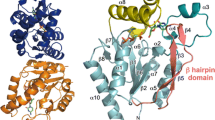Abstract.
Deoxyribonucleoside kinases phosphorylate deoxyribonucleosides, a crucial reaction in biosynthesis of DNA precursors through the salvage pathway. Their medical interest stems from their activation of a number of anticancer and antiviral drugs such as 2-chloro-2′-deoxyadenosine, azidothymidine and acyclovir. Here we review what is presently known about each of the mammalian kinases as well as some other members of the deoxyribonucleoside kinase family. A description of the biochemical properties of the enzymes is followed by an overview of the structural studies made on this family of enzymes, including the catalytic mechanism as well as the mechanism for feedback inhibition. A presentation of homology models of other proteins in the family is made and, finally, the determinants of substrate and substrate analog specificities are described.
Article PDF
Similar content being viewed by others
Avoid common mistakes on your manuscript.
Author information
Authors and Affiliations
Additional information
Received 8 February 2002; received after revision 21 March 2002; accepted 26 March 2002
Rights and permissions
About this article
Cite this article
Eriksson, S., Munch-Petersen, B., Johansson, K. et al. Structure and function of cellular deoxyribonucleoside kinases. CMLS, Cell. Mol. Life Sci. 59, 1327–1346 (2002). https://doi.org/10.1007/s00018-002-8511-x
Issue Date:
DOI: https://doi.org/10.1007/s00018-002-8511-x



